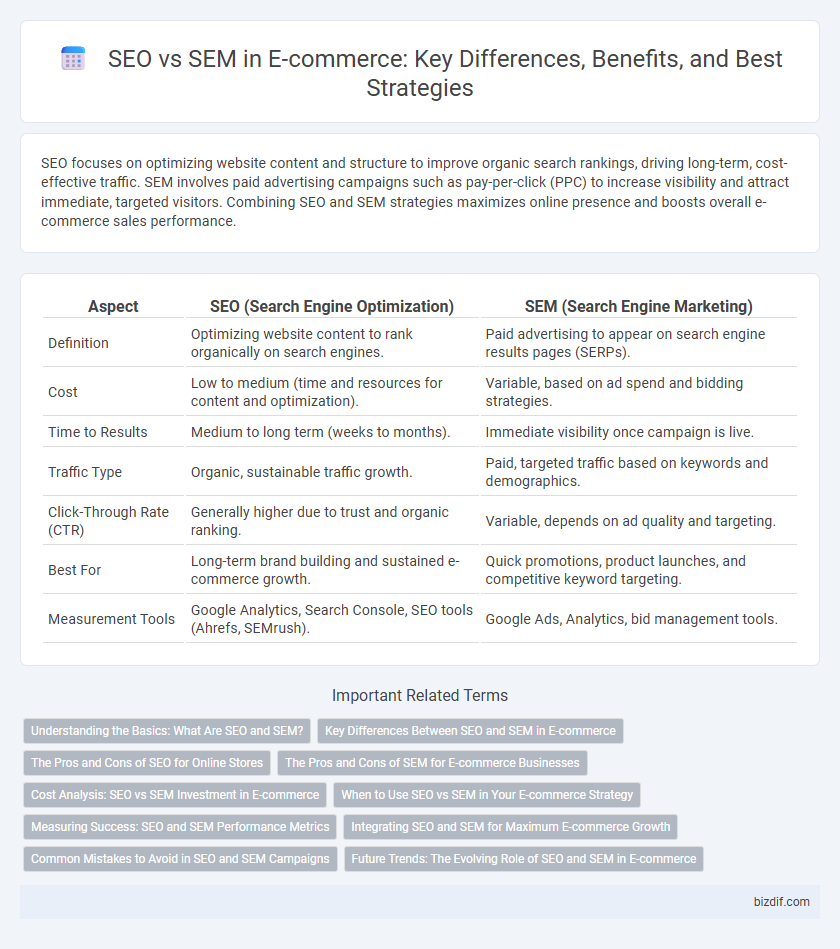SEO focuses on optimizing website content and structure to improve organic search rankings, driving long-term, cost-effective traffic. SEM involves paid advertising campaigns such as pay-per-click (PPC) to increase visibility and attract immediate, targeted visitors. Combining SEO and SEM strategies maximizes online presence and boosts overall e-commerce sales performance.
Table of Comparison
| Aspect | SEO (Search Engine Optimization) | SEM (Search Engine Marketing) |
|---|---|---|
| Definition | Optimizing website content to rank organically on search engines. | Paid advertising to appear on search engine results pages (SERPs). |
| Cost | Low to medium (time and resources for content and optimization). | Variable, based on ad spend and bidding strategies. |
| Time to Results | Medium to long term (weeks to months). | Immediate visibility once campaign is live. |
| Traffic Type | Organic, sustainable traffic growth. | Paid, targeted traffic based on keywords and demographics. |
| Click-Through Rate (CTR) | Generally higher due to trust and organic ranking. | Variable, depends on ad quality and targeting. |
| Best For | Long-term brand building and sustained e-commerce growth. | Quick promotions, product launches, and competitive keyword targeting. |
| Measurement Tools | Google Analytics, Search Console, SEO tools (Ahrefs, SEMrush). | Google Ads, Analytics, bid management tools. |
Understanding the Basics: What Are SEO and SEM?
SEO (Search Engine Optimization) involves optimizing e-commerce websites through keyword research, on-page content, and backlink building to improve organic search rankings and increase free traffic. SEM (Search Engine Marketing) includes paid strategies like PPC (pay-per-click) advertising to boost visibility on search engine results pages through targeted ads and bidding on keywords. Both SEO and SEM aim to drive qualified traffic, enhance online presence, and improve conversion rates in competitive digital marketplaces.
Key Differences Between SEO and SEM in E-commerce
SEO in e-commerce focuses on optimizing website content and structure to improve organic search rankings, targeting long-term visibility and cost-efficiency. SEM involves paid advertising campaigns, such as Google Ads, to generate immediate traffic and conversions by bidding on keywords. Understanding the key differences highlights SEO's emphasis on sustained growth through organic traffic, while SEM prioritizes quick results with budget-managed ad spending.
The Pros and Cons of SEO for Online Stores
SEO for online stores boosts organic traffic through optimized product descriptions, keyword-rich content, and improved site structure, resulting in long-term cost savings compared to paid ads. However, SEO requires significant time investment and ongoing content updates to maintain rankings amidst competitive markets. Limited immediate visibility and slower return on investment pose challenges for fast-growing e-commerce businesses aiming for rapid expansion.
The Pros and Cons of SEM for E-commerce Businesses
SEM for e-commerce businesses offers immediate visibility through paid ads, driving targeted traffic and boosting sales with measurable ROI. However, high costs and ongoing budget management can limit long-term sustainability, especially for small to mid-sized businesses. Reliance on paid advertising also means vulnerability to market competition and fluctuating ad auction prices, impacting profit margins.
Cost Analysis: SEO vs SEM Investment in E-commerce
SEO investment in e-commerce offers long-term cost efficiency by driving organic traffic without recurring ad spend, making it ideal for sustained growth. SEM requires higher upfront costs through pay-per-click campaigns but delivers immediate visibility and targeted traffic, which can accelerate short-term sales. Evaluating budget allocation depends on campaign goals, with SEO requiring consistent content and technical optimization expenses while SEM demands ongoing bidding and ad management costs.
When to Use SEO vs SEM in Your E-commerce Strategy
SEO is ideal for building long-term organic traffic and improving search rankings through keyword optimization, quality content, and site structure enhancements in e-commerce. SEM is best for immediate visibility and traffic by using paid ads like Google Ads to target high-intent buyers with precise keyword bids. Combining SEO and SEM in an e-commerce strategy maximizes reach and conversions, ensuring sustained growth and quick sales boosts during promotional periods.
Measuring Success: SEO and SEM Performance Metrics
SEO success is measured through organic traffic, keyword rankings, and bounce rates, focusing on long-term growth and user engagement. SEM performance relies on click-through rates (CTR), cost per click (CPC), conversion rates, and return on ad spend (ROAS) to evaluate paid campaign effectiveness. Combining analytics from Google Analytics and Google Ads provides comprehensive insights for optimizing both strategies in e-commerce.
Integrating SEO and SEM for Maximum E-commerce Growth
Integrating SEO and SEM strategies amplifies e-commerce growth by enhancing both organic visibility and paid search performance. Leveraging data from SEM campaigns informs keyword optimization in SEO, driving targeted traffic with higher conversion potential. Coordinated efforts in content creation, keyword bidding, and performance analytics maximize ROI and accelerate customer acquisition.
Common Mistakes to Avoid in SEO and SEM Campaigns
Ignoring keyword research and targeting irrelevant terms leads to poor SEO and SEM performance by attracting unqualified traffic. Neglecting proper campaign tracking and data analysis results in wasted budget and missed opportunities for optimization. Failing to optimize landing pages for user experience reduces conversion rates, undermining the effectiveness of both SEO and SEM efforts.
Future Trends: The Evolving Role of SEO and SEM in E-commerce
SEO and SEM are converging in e-commerce with AI-driven algorithms enhancing search intent analysis and personalized advertising. Voice search optimization and visual search integration are transforming SEO strategies, while SEM leverages automation for dynamic bidding and real-time targeting. The future landscape prioritizes seamless customer journeys through omnichannel marketing, driving higher conversion rates and improved ROI.
SEO vs SEM Infographic

 bizdif.com
bizdif.com